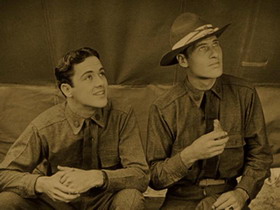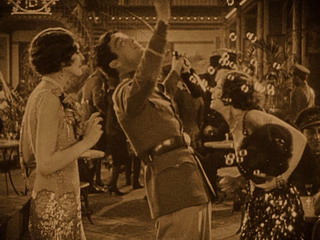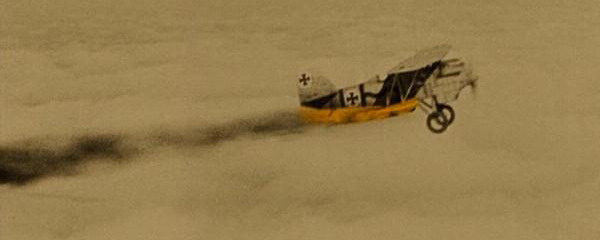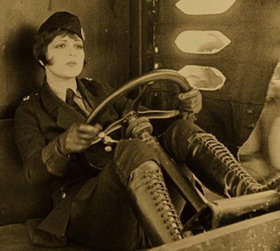Last week I posted how Russ and I are going to do “Saturday Night at the Drive-in,” a festival of B-movies. Lest you think we are total lowbrows, I’m here now to tell you that we are also instituting another tradition: Sunday Night at the Academy Awards. Of course it might not be every Sunday, and it might not actually be on Sunday, but every now and then we plan to watch an Academy Award winning film. For the cultural experience. And to balance out the B films with some A+ cinematic outings.
Russ being such a chronologist, he wants to go in order, and I have no problem with that. It will be a lesson in film history. To start us off, last week we watched Wings, the 1927 silent film that won the very first Academy Award for Best Motion Picture.
Now, to tell you the truth, I was kind of dreading this. Not only is in black and white, but it’s also silent, and to top it all off, the film runs over 2 hours and 20 minutes! Ugh! Right? No. Wrong! It was absolutely delightful. This film  has everything. It’s a war story, it’s a love story, it’s about friendship, there’s melodrama and pathos, social commentary, and even a bit of comedy.
has everything. It’s a war story, it’s a love story, it’s about friendship, there’s melodrama and pathos, social commentary, and even a bit of comedy.
But by far I think the stars of this film are…the stars! For one thing: Clara Bow. Now, I had studied film in college, but I don’t ever remember running into a Clara Bow performance, and I imagine that if I had, I would have remembered her. For not even being able to get her point across verbally, she’s incredibly expressive. Of course in these silent films it’s all about facial expression and gesturing and posturing, and she’s got all that down. When her eyes and her lips turn down in sadness, you feel for her. And when she’s  jumping around in glee, you feel like jumping around as well. She’s so appealing, I completely understand why she was the big star of the day.
jumping around in glee, you feel like jumping around as well. She’s so appealing, I completely understand why she was the big star of the day.
The other main players are Charles “Buddy” Rogers and Richard Arlin, who were relative newcomers at the time and went on to have successful careers, but I don’t think ever rose to the iconic status of Clara Bow (she was, after all “The It Girl” of the Flapper era). They’re both in love with the same girl (and guess what, it’s NOT Clara Bow!), so there’s some tension between them, but the perils of war cement their friendship into a  sort of “bromance,” long before the word bromance was ever dreamed up.
sort of “bromance,” long before the word bromance was ever dreamed up.
But wait! There are even more stars in this film. Gary Cooper appears in a brief scene that helped his Hollywood career really take off. But more than that, I was so impressed by the spectacle, and the use of special effects. As for spectacle, the US military participated in the making of this film, providing planes and soldiers, thinking this was going to be a sort of military PR film. I didn’t exactly see it that way, but perhaps the audiences of the day, eight years out from the end of World War I, found the war aspects of it affirming and inspiring.
But most impressive: I really got a big kick out of the scenes in the Paris dancehall, where one of our fighter pilots is rip-roaring drunk, and sees bubbles everywhere.  I had no idea they were doing stuff like even before sound had been added to film! It was surprising, and refreshing as a glass of champagne.
I had no idea they were doing stuff like even before sound had been added to film! It was surprising, and refreshing as a glass of champagne.
Also in the special effects department: when the planes are shot down, we see yellow fire in the exhaust. Look! Color! We were certain this was an effect added in for re-release of the movie decades later, but watching the DVD documentary about the making of the film, we learned that this effect was actually available when audiences saw the movie back in 1927. I guess someone painstakingly added color (paint? I don’t know, how would they do that?) to each and every frame of film that needed it.

Another thing 1927 audiences got with this film was full orchestral accompaniment. No kidding. We watched the film with the traditional silent movie organ soundtrack, which was quite entertaining in itself, but later learned that there is a full orchestral version available as well. And the music is GOOD! I mean, I’ve put this movie on my Amazon wish list, because I imagine it as the kind of thing you could have playing in the background while you’re cleaning the house on a Saturday afternoon, or writing or editing a blog post.
Wings cost $2 million to make, and was the biggest thing that had ever happened up to that point. It ran in New York City for 63 weeks. Nowadays, a great movie is lucky to get a few months, and a mediocre one single digit weeks. Not only that, in the big cities, people paid two dollars to see this movie. Do you know how much  money that was back in 1927? Offhand, I don’t know, but a quick check on the internet tells me the average wage in 1927 was fifty cents a day. So, almost a week’s salary….to see a movie! Geez!
money that was back in 1927? Offhand, I don’t know, but a quick check on the internet tells me the average wage in 1927 was fifty cents a day. So, almost a week’s salary….to see a movie! Geez!
I guess I could go on and on, but that’s enough for now, as there are other movies to watch. Later today, I’ve got to choose the next B movie for tonight’s showing. I’m glad we’re taking on the Academy Award winners as well. Having watched Wings, it’s amazing to me to see that placement on the timeline really has very little to do with quality. The best movie of 1927 is a thousand times better than the worst movie of 2012. And frankly, I can’t wait to see what the Academy Award winner of 1928 will be!


